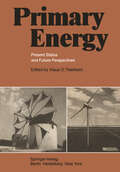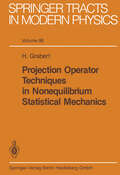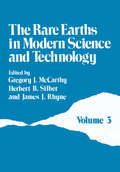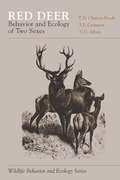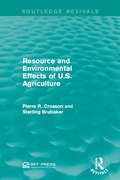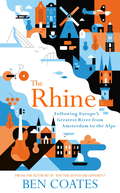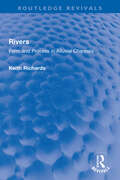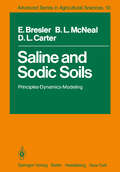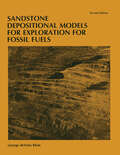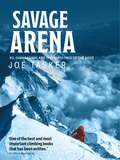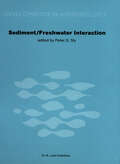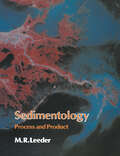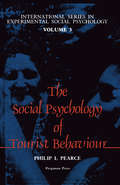- Table View
- List View
Ore Genesis: The State of the Art (Special Publication of the Society for Geology Applied to Mineral Deposits #2)
by G. C. Amstutz A. El Goresy G. Frenzel C. Kluth G. Moh A. Wauschkuhn R. A. ZimmermannPalaeoecology of Africa, volume 14 (Palaeoecology Of Africa Ser.)
by J. A. K. Coetzee E. M. Van Zinderen BakkerThis reference provides up-to-date information on research in many different disciplines which give an overall insight into the environmental history of Africa.
Palaeoecology of Africa, volume 14 (Palaeoecology Of Africa Ser.)
by J. A. Coetzee E. M. Van Zinderen Barker SRThis reference provides up-to-date information on research in many different disciplines which give an overall insight into the environmental history of Africa.
The Petroleum Resources of Indonesia (Natural Resources of South-East Asia)
by Ooi Jin BeeTHE quadrupling of oil prices within a few months in late 1973 and early 1974 brought to an abrupt end the era of inexpensive oil. Since then the continuing increases in the price of oil traded in the international market and the higher prices of imports of manu factured goods have seriously disrupted the foreign exchange balances of many developing countries and forced them to replan their development programmes. The impact of high oil prices is felt in every country, whether developed or developing, and has brought to world attention the fact that not only are petroleum resources in limited supply and exhaustible but also that substitutes cannot be found easily or quickly. In a world faced with the certainty of declining supplies of petroleum there is widespread interest and concern among all the oil producing countries to evaluate the extent of their petroleum resources and to examine more closely the problems of their development, rates of depletion and methods of conservation. The present work reviews some of the above issues and problems in relation to Indonesia, an OPEC member, and the major oil producing country in South-East Asia. More specifically, it seeks to provide the reader with an overview of the petroleum resources of the country their nature, extent, distribution as well as the problems of their development.
Primary Energy: Present Status and Future Perspectives
by Klaus O. ThielheimThe enormous public interest of specialists as well as of engaged and concerned citizens in the energy problem can be understood in view of the fact that the future of national and world-wide economy depends on the availability of sufficient primary energy. The questions arising are: which forms of primary energy exist principally? by what means and at what cost can they be brought to useful application? and what is their possible role in the present and future energy scenario? Another reason which may not be so obvious, but which eventually may prove to be of great importance as far as public acceptance of energy technologies is con cerned, lies in the fact that the existing conscious or subconscious fears arising from confrontation with scientific and technological progress - to which even for the educated layman intellectual access is diffi cult - have been sublimated onto the energy problem and especially onto the problem of nuclear energy. Un like other developments, the emergence of nuclear ener gy has brought to our notice the ambivalence of ad vancing science and technology, which may either be used peacefully or misused militarily. Nuclear energy can help to overcome the increasing hunger for energy in the world, but it can also lead to the extinction of human life from the surface of this plant. More and more, mankind is confronted with chances and risks of new discoveries.
Primate Brain Evolution: Methods and Concepts
by Este Armstrong Dean FalkGiven the past decade's explosion of neurobiological and paleontologi cal data and their increasingly sophisticated analyses, interdisciplinary syntheses between these two broad disciplines are of value and interest to many different scientists. The collected papers of this volume will appeal to students of primate and hominid evolution, neuroscientists, sociobiolo gists, and other behaviorists who seek a better understanding of the substrates of primate, including human, behavior. Each species of living primates represents an endpoint in evolution, but comparative neurologists can produce approximate evolutionary se quences by careful analyses of representative series. Because nervous tissue does not fossilize, only a comparison of structures and functions among extant primates can be used to investigate the fine details of primate bra~n evolution. Paleoneurologists, who directly examine the fossil record via endocasts or cranial capacities of fossil skulls, can best provide information about gross details, such as changes in brain size or sulcal patterns, and determine when they occurred. Physical anthropologists and paleontologists have traditionally relied more on paleoneurology, whereas neuroscientists and psychologists have relied more on comparative neurology. This division has been a detriment to the advancement of these fields and to the conceptual bases of primate brain evolution. Both methods are important and a synthesis is desirable. To this end, two symposia were held in 1980--one at the meeting of the American Association of Physical Anthro pologists in Niagara Falls, U. S. A. , and one at the precongressional meeting of the International Primatological Society in Torino, Italy.
Principles of Geodynamics
by A.E. ScheideggerGeodynamics is commonly thought to be one of the subjects which provide the basis for understanding the origin of the visible surface features of the Earth: the latter are usually assumed as having been built up by geodynamic forces originating inside the Earth ("endogenetic" processes) and then as having been degrad ed by geomorphological agents originating in the atmosphere and ocean ("exogenetic" agents). The modem view holds that the sequence of events is not as neat as it was once thought to be, and that, in effect, both geodynamic and geomorphological processes act simultaneously ("Principle of Antagonism"); however, the division of theoretical geology into the principles of geodynamics and those of theoretical geomorphology seems to be useful for didactic purposes. It has therefore been maintained in the present writer's works. This present treatise on geodynamics is the first part of the author's treatment of theoretical geology, the treatise on Theoretical Geomorphology (also published by the Springer Verlag) representing the second. The present edition is third one of the book. Although the headings of the chapters and sections are much the same as in the previous editions, it will be found that most of the material is, in fact, new.
Projection Operator Techniques in Nonequilibrium Statistical Mechanics (Springer Tracts in Modern Physics #95)
by H. GrabertThe Rare Earths in Modern Science and Technology: Volume 3
by J. McCarthyThe Fifteenth Rare Earth Research Conference was held June 15-18, 1981 on the Rolla campus of th.e University of Missouri. The conference was hosted by the Graduate Center for Materials Research, the College of Arts and Science, and the School of Mines and Metallurgy. It was expected that the conference would provide a forum for critical examination and review of the current and important trends in rare earth science and technology. To this end, over 170 papers were presented in both oral and poster sessions by researchers representing some nineteen countries. The program committee was particularly gratified to see the diversity of effort being devoted to rare earth research by different disciplines allover the world. The collection of refereed papers in this volume attests to the fact that the objectives of the program committee were indeed realized. A high point of the meeting was the presentation of the Frank n. Spedding Award to a most distinguished colleague, Professor Georg Busch, Eidgenossische Technische Hochschule, Zurich. Prof essor W. Edward hi"allace, University of Pittsburgh, recipient of the first Frank H. Spedding Award made the presentation to Professor Busch who then gave the Plenary Address.
Real-Space Renormalization (Topics in Current Physics #30)
by T. W. Burkhardt J. M. J. Van LeeuwenThe renormalization-group approach is largely responsible for the considerable success which has been achieved in the last ten years in developing a complete quantitative theory of phase transitions. Before, there was a useful physical picture of phase transitions, but a general method for making accurate quantitative predictions was lacking. Existent theories, such as the mean-field theory of Landau, sometimes reproduce phase diagrams reliably but were known to fail qualitatively near critical points, where the critical behavior is particularly interesting be cause of its universal character. In the mid 1960's Widom found that the singularities in thermodynamic quanti ties were well described by homogeneous functions. Kadanoff extended the homogeneity hypothesis to correlation functions and linked it to the idea of scale invariance. In the early 1970's Wilson showed how Kadanoff's rescaling could be explicitly carried out near the fixed point of a flow in Hamiltonian space. He made the first practical renormalization-group calculation of the flow induced by the elimination of short-wave-length Fourier components of the order-parameter field. The univer sality of the critical behavior emerges in a natural way in this approach, with a different fixed point for each universality class. The discovery by Wilson and Fisher of a systematic expansion procedure in E for a system in d = 4 - E dimen sions was followed by a cascade of calculations of critical quantities as a function of d and of the order-parameter dimensionality n.
Red Deer: Behavior and Ecology of Two Sexes (Wildlife Behavior and Ecology series)
by T. H. Clutton-Brock F. E. Guinness S. D. AlbonRed Deer: Behavior and Ecology of Two Sexes is the most extensive study yet available of reproduction in wild vertebrate. The authors synthesize data collected over ten years on a population of individually recognizable red deer, usually regarded as conspecific with the American elk. Their results reveal the extent of sex differences in behavior, reproduction, and ecology and make a substantial contribution to our understanding of sexual selection.
Resource and Environmental Effects of U.S. Agriculture (Routledge Revivals)
by Pierre R. Crosson Sterling BrubakerOriginally published in 1982, this report explores long-term trends in demand for U.S. agricultural production, energy prices and agricultural technologies and their effect on natural resources such as land and water in the United States. Crosson and Brubaker also discuss possible policy modifications in order to lessen the environmental impacts expected to emerge from these trends. This title will be of interest to students of Environmental Studies.
Resource and Environmental Effects of U.S. Agriculture (Routledge Revivals)
by Pierre R. Crosson Sterling BrubakerOriginally published in 1982, this report explores long-term trends in demand for U.S. agricultural production, energy prices and agricultural technologies and their effect on natural resources such as land and water in the United States. Crosson and Brubaker also discuss possible policy modifications in order to lessen the environmental impacts expected to emerge from these trends. This title will be of interest to students of Environmental Studies.
The Rhine: Following Europe’s Greatest River from Amsterdam to the Alps
by Ben CoatesThe Rhine is one of the world's greatest rivers. Once forming the outer frontier of the Roman Empire, it flows 800 miles from the social democratic playground of the Netherlands, through the industrial and political powerhouses of Germany and France, to the wealthy mountain fortresses of Switzerland and Liechtenstein. For five years, Ben Coates lived alongside a major channel of the river in Rotterdam, crossing it daily, swimming and sailing in its tributaries. In The Rhine, he sets out by bicycle from the Netherlands where it enters the North Sea, following it through Germany, France and Liechtenstein, to its source in the icy Alps. He explores the impact that the Rhine has had on European culture and history and finds out how influences have flowed along and across the river, shaping the people who live alongside it. Blending travelogue and offbeat history, The Rhine tells the fascinating story of how a great river helped shape a continent.
Rivers: Form and Process in Alluvial Channels (Routledge Revivals)
by Keith RichardsOriginally published in 1982, this book presents a detailed review of alluvial river form and process and integrates the distinct but related approaches of geomorphologists, geologists and engineers to the subject. It outlines the environmental catchment factors that control the development of channel equilibrium and provides a detailed account of the sediment transport processes that represent the physical mechanisms by which channel adjustment occurs. Where possible it evaluates theoretical analyses in the context of the empirical evidence. Rivers should prove a valuable textbook for geomorphology students on advanced undergraduate courses on river behaviour and will also be of interest to students of hydraulics and sedimentology and to those concerned with civil and environmental engineering, river management and channel design, maintenance and management in the water industry
Rivers: Form and Process in Alluvial Channels (Routledge Revivals)
by Keith RichardsOriginally published in 1982, this book presents a detailed review of alluvial river form and process and integrates the distinct but related approaches of geomorphologists, geologists and engineers to the subject. It outlines the environmental catchment factors that control the development of channel equilibrium and provides a detailed account of the sediment transport processes that represent the physical mechanisms by which channel adjustment occurs. Where possible it evaluates theoretical analyses in the context of the empirical evidence. Rivers should prove a valuable textbook for geomorphology students on advanced undergraduate courses on river behaviour and will also be of interest to students of hydraulics and sedimentology and to those concerned with civil and environmental engineering, river management and channel design, maintenance and management in the water industry
Saline and Sodic Soils: Principles-Dynamics-Modeling (Advanced Series in Agricultural Sciences #10)
by E. Bresler B. L. McNeal D. L. CarterIn keeping with the spirit of an Advanced Series in the Agricultural Sciences, we have attempted to address herein most of the current research areas being used to characterize, describe and manage salt-affected soils. Because of a certain amount of personal bias inherent in our individual viewpoints and backgrounds, some areas have been accorded more emphasis than others. It has been our goal, however, to provide either detail about, or at least a recent reference to, each major area of current soil salinity research. This information, coupled with what we hope to be a rather logical progression from descriptive material on equilibrium or near-equilibrium soil chemistry, through transport processes, to eventual management practices including some elementary economic decisions, should enable the reader to bridge the gap from introductory soil chemistry or soil physics texts to the basic literature of this area. The text will be perceived by the astute reader as somewhat uneven in its treatment of respective sections. We feel that this is to a certain extent appropriate, for it thus portrays the unevenness of progress to date in the corresponding areas of research. The management of saline and sodic soils remains largely an empirical semi-science or even art, whereas transport phenomena are normally dealt with in a much more theoretical (and also a much more highly mathematical) vein. Equilibrium soil chemistry has historically occupied an intermediate position with respect to its mix of empiricism and theoretical rigor.
Sandstone Depositional Models for Exploration for Fossil Fuels
by G. Devries KleinThe purpose of this monograph is to provide participants in my various short courses with a brief statement of the material I cover in my lectures. In addition, key illustrations are reproduced for guidance. A brief bibliography of reference material is appended to each chapter. The bibliographic material includes those references that I consider critical to my remarks. No claim is made of topical or bibliographic completeness. This monograph also is intended as a brief summary of depositional processes, Holocene sediments, ancient counterparts of depositional environments, and examples of oil- and gas-bearing stratigraphic traps in five depositional environments. This summary is intended to complement lecture and reading courses dealing with sedimentology, depositional systems, sedimentary facies, sedimentary environments, sandstone diagenesis, and sedimentary modelling as a predictive tool for exploration. The student is cautioned, however, that this monograph is merely an introduction and summary overview of the subject. More complete treatments appear in standard textbooks. Sedimentology has changed and advanced over the past twenty-five years, in part because the American oil industry needed to make predictions about the occurrence of the harder-to-find stratigraphic traps. In addition, the development of plate-tectonic theory, and supportive data from the Deep Sea Drilling Project, have caused sedimentology to change from an essentially descriptive science to a mature, predictive science. The 1960s and 1970s in particular witnessed an explosion of new insights and understanding of how sediments are deposited, and how sedimentary rocks are formed.
Savage Arena: K2, Changabang and the North Face of the Eiger
by Joe TaskerI could never again maintain that I was caught up in this game unwillingly. I knew now what I wanted to do. Willingly would I accept the hardship and fear, the discipline and the sacrifices, if only I could be given back the chance to climb that mountain.' Joe Tasker lies, struck down by a tooth abscess, in a damp, bug-infested room in the Himalaya, wondering if he will be well enough to climb Dunagiri, his first venture to the 'big' mountains. He is there with Dick Renshaw to attempt to make a two-man ascent of the Peak - one of the first true Alpine-style expeditions to the Greater Ranges; an attempt that forms part of this tale of adventure in the savage vertical arena of hostile mountains. Joe Tasker was one of Britain's foremost mountaineers. A pioneer of lightweight mountaineering and a superbly gifted writer, in Savage Arena he vividly describes his participation in the first British winter ascent of the North Face of the Eiger; his first ascent of the West Wall of Changabang with Peter Boardman - considered to be a preposterous plan by the established climbing world; the first ascent of the North Ridge of Kangchenjunga; and his two unsuccessful attempts to climb K2, the second highest mountain in the world. This is a story of single-minded determination, strength and courage in a pursuit which owes much of its value and compulsion to the risks entailed - risks which often stimulate superlative performances. It is also a story of the stresses, strains and tensions of living in constant anxiety, often with only one other person, for long periods in which one is never far from moments of terror, and of the close and vital human relationships which spring from those circumstances. It is a moving, exciting and inspirational book about the adventuring spirit which seeks endless new climbing challenges to face, alluring problems to solve and difficulties to overcome, for it is not reaching the summit which is important, but the journey to it. Joe Tasker and Peter Boardman died on Everest in 1982, while attempting a new and unclimbed line. Both men were superb mountaineers and talented writers. Tasker's first book, Everest the Cruel Way, was first published in 1981. Savage Arena, his second book, was completed just before he left for Everest. Both books have become mountaineering classi. The literary legacy of Tasker and Boardman lives on through the Boardman Tasker Prize for Mountain Literature, established by family and friends in 1983 and presented annually to the author or co-authors of an original work which has made an outstanding contribution to mountain literature. For more information about the Boardman Tasker Prize, visit: www.boardmantasker.com 'The most riveting book on climbing that I have ever read.' Chris Bonington 'A gripping story of tremendous courage and unbelievable endurance.' Sir Edmund Hillary
Sediment/Freshwater Interactions: Proceedings of the Second International Symposium held in Kingston, Ontario, 15–18 June 1981 (Developments in Hydrobiology #9)
by P.G. SlyProceedings of the Second International Sediment/Freshwater Symposium held in Kingston, Ontario, June 15-18, 1981
Sedimentology: Process and Product
by M.R. LeederThe origin, dispersal, deposition and burial of natural sediment grains is the central concern of sedimentology. The subject is truly inter disciplinary, commands the attention of Earth scientists, is of consider able interest to fluid dynamicists and civil engineers, and it finds widespread practical applications in industry. Sedimentology may be approached from two viewpoints: a descrip tive approach, as exemplified by traditional petrography and facies analysis, and a quantitative approach through the physical and chemical sciences. Both approaches are complementary and must be used in tandem if the recent remarkable progress in the field is to be sustained. This text aims to introduce such a combined approach to senior undergraduate students, graduate students and to interested professional Earth scientists. Thus the many descriptive diagrams in the text are counterbalanced by the use of basic physical and chemical reasoning through equations. I have tried to construct a text that follows logically on from the origin of sediment grains through fluid flow, transport, deposition and diagenesis (the change from sediment to rock). The text has been written assuming that some basic previous instruction has been given in the Earth sciences and in general physics and chemistry. Certain important derivations are given in appendices. I have avoided advanced mathematical treatment since it is my opinion that recogni tion of the basic physical or chemical basis to a problem is more important to the student than the formal mathematical reduction of poorly gathered data. As T. H.
A Short Introduction to Perturbation Theory for Linear Operators
by Tosio KatoThis book is a slightly expanded reproduction of the first two chapters (plus Introduction) of my book Perturbation Theory tor Linear Operators, Grundlehren der mathematischen Wissenschaften 132, Springer 1980. Ever since, or even before, the publication of the latter, there have been suggestions about separating the first two chapters into a single volume. I have now agreed to follow the suggestions, hoping that it will make the book available to a wider audience. Those two chapters were intended from the outset to be a comprehen sive presentation of those parts of perturbation theory that can be treated without the topological complications of infinite-dimensional spaces. In fact, many essential and. even advanced results in the theory have non trivial contents in finite-dimensional spaces, although one should not forget that some parts of the theory, such as those pertaining to scatter ing. are peculiar to infinite dimensions. I hope that this book may also be used as an introduction to linear algebra. I believe that the analytic approach based on a systematic use of complex functions, by way of the resolvent theory, must have a strong appeal to students of analysis or applied mathematics, who are usually familiar with such analytic tools.
Simple Seismics for the petroleum geologist, the reservoir engineer, the well-log analyst, the processing technician, and the man in the field
by N.A. AnsteyThis little book is different. It is written, primarily, for geologists, reservoir engineers, and log analysts. Why? Because today's seismic method is more than a tool for reconnaissance exploration, for finding structures; it has become a tool for studying the discovered reservoir-its extent, its barriers, its variations of thickness, and its trends of porosity. Today, the geophysicist, the geolog ist, the engineer, and the log analyst can do great things together. Because the book is not written primarily for geophysi cists, it can skip much of the "mechanics" of the seismic method. The reader who reaches the last page (bless him!) will not be able to practise the seismic method, but he will understand how the seismic method can help to solve his problems. It may also be of value to those practitioners of the seismic method-in the field or in the processing centre-who already know the mechanics of the method, but would like to take a broader view. 1 1 Seismics and Structure Of all the geophysical methods working from the surface, there is only one which is widely accepted for studies of individual petroleum reservoirs-the seismic reflection method. We would dearly love to have something better, but alas ... Reduced to its essentials, the method is this: we make a bang, and we listen for echoes.
The Social Psychology of Tourist Behaviour: International Series in Experimental Social Psychology
by Philip L. PearceThe Social Psychology of Tourist Behaviour is a seven-chapter book that describes tourists, tourism, and tourist psychology. The book particularly explores economic, geographical, anthropological, and sociological studies of tourism. Subsequent chapters look into the social role of tourist; an approach to tourist motivation; social contact between tourists and hosts; and environmental settings of tourist behavior. The book will be useful for advanced undergraduates, graduate students and relevant practitioners, and in some cases for a rather broader public in the field of social psychology.



